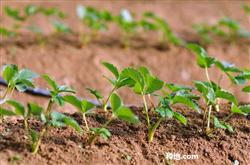How to manage strawberries for high yield?

How to manage strawberries for high yield? Please guide if you want high yield of strawberry, you can refer to the following strawberry planting techniques: 1, uncover film and refine seedlings. The mulch began to be removed when the average temperature was about 10 ℃, and all was removed in the middle and last ten days of March. Before removing it, we must do a good job in refining seedlings. 2. Ploughing and regulating soil moisture. Shallow hoeing should be carried out in mid-ploughing to avoid damaging the root system and preventing soil clods from crushing the seedlings, and clearing ditches and regulating soil moisture to prevent waterlogging damage. 3. Cut off the old leaves. After strawberries begin to grow, the withered old leaves and diseased leaves should be cut off in time, and should be taken out of the field and concentrated to compost, so as to reduce the source of bacteria. 4. Topdressing in time. In the middle and last ten days of March, it is necessary to apply urea 10kg / mu or compound fertilizer 20kg / mu in combination with watering. In mid-April, we should use 10kg / mu of urea and 10kg / mu of compound fertilizer before flowering and fruiting. In addition, foliar spraying 0.3% potassium dihydrogen phosphate solution for 3 times during flowering and fruiting period has a good effect on improving yield and quality. 5. Rational irrigation. It is necessary not only to meet the physiological water needs of strawberries, but also to strictly prevent stains. Generally before budding, fruit expansion and ripening period, each irrigation should be appropriate, do not flood irrigation. 6. Thinning flowers and buds. The thin buds of strawberries should be removed after budding, so as to reduce the consumption of nutrients, concentrate the supply of nutrients to the buds that open first, and promote the fruit to be large, neat, early ripening and good quality. Generally, when the buds on the inflorescence are separated from each other and are easy to be removed, 20% to 25% of the late weak buds are removed. 7. Prevention and control of diseases and pests. For fungal diseases such as leaf spot, gray mold, Verticillium wilt, bud blight, powdery mildew and so on, Bordeaux solution, methyl thiophanate and carbendazim can be used in early spring, especially after the disease occurs, the disease should be controlled in the initial stage. Virus diseases are mainly transmitted by aphids, so it is necessary to prevent and control aphids. In addition, ground tigers, grubs, mole crickets and other underground pests can be irrigated and killed with phoxim solution of 1000-1500 times, and triclofenac and propargite can be used to kill red spiders. Note that the application of chemical pesticides is prohibited during fruit ripening. Click to get more strawberry planting techniques click to get more fruit planting techniques
- Prev

How to fertilize strawberries scientifically?
How to fertilize strawberries scientifically? Please introduce that the fertilization of strawberries can be divided into base fertilizer and topdressing. The main results are as follows: (1) Base fertilizer: strawberry cultivation density is high, and it is not convenient to supplement fertilizer during the growing period. Base fertilizer had better be applied at one time and combined with nitrogen, phosphorus and potassium fertilizer to meet the nutrients needed for the whole growth cycle of strawberry. Generally, 5000 kg of base fertilizer is applied per mu.
- Next

How do strawberries grow seedlings?
How do strawberries grow seedlings? Please introduce the methods of strawberry seedling cultivation: 1. in order to reduce the nutrient consumption of the mother plant and promote the emergence of the seedling, the old and diseased leaves of the mother plant and the flower stem must be removed in time; at the same time, the plant should be sprayed with 50ppm gibberellin (20 kg / g of gibberellin mixed with water).
Related
- Moge, come on! The staff of the peasant association in the producing area of cantaloupe were frightened when the crowd gathered.
- Causes and Solutions of low Fruit setting rate of Apple
- Symptoms and control measures of passion fruit virus disease
- Fruit growing lesson: how do apple orchards keep high yields?
- Can you build orchards in the mountains? What are the pros and cons?
- How to manage the coloring period of Crisson grape?
- This paper introduces the processing technology of two kinds of fig products.
- How much is a month for retired teachers in rural areas by 2020?
- How can strawberry planting increase sugar content? We should pay attention to management in many aspects.
- What are the cultivation techniques on how to improve the yield of golden fruit?

